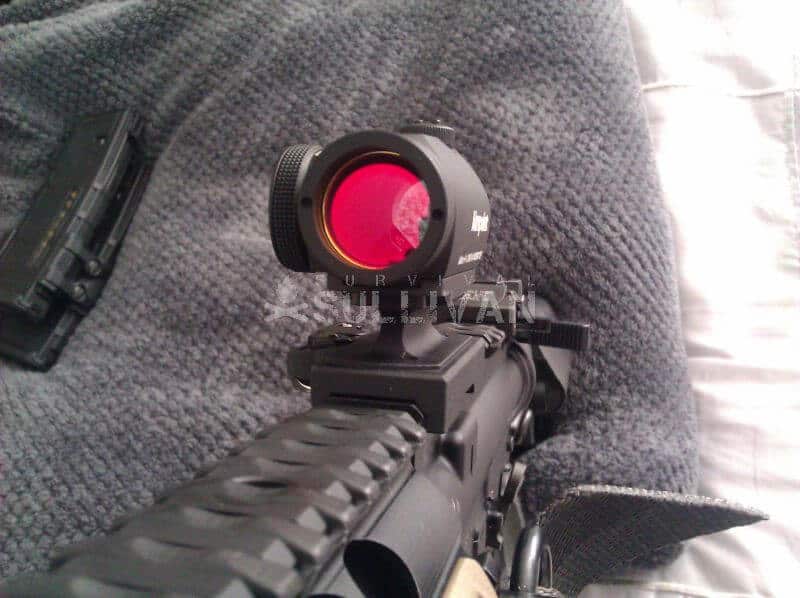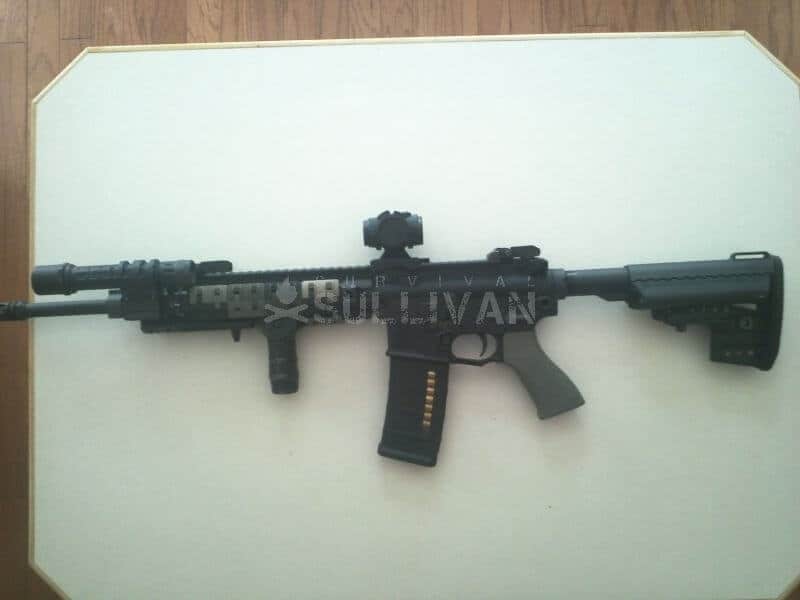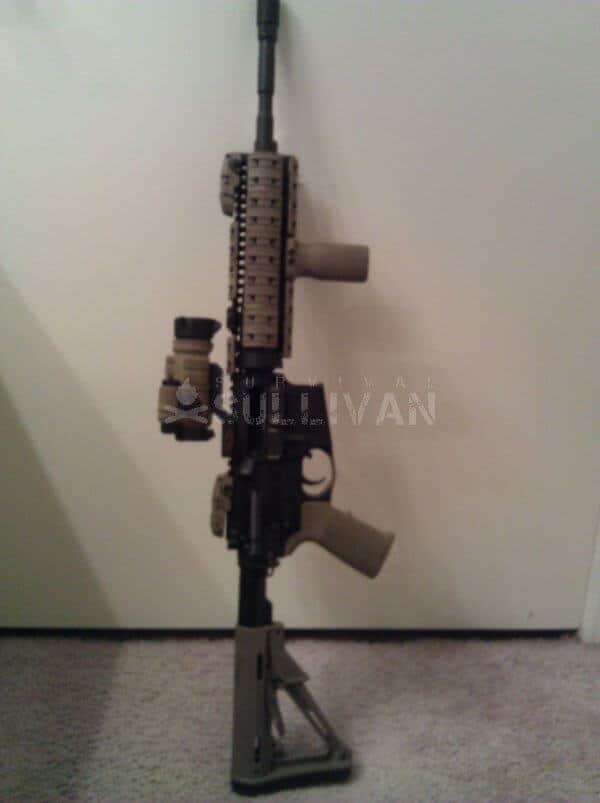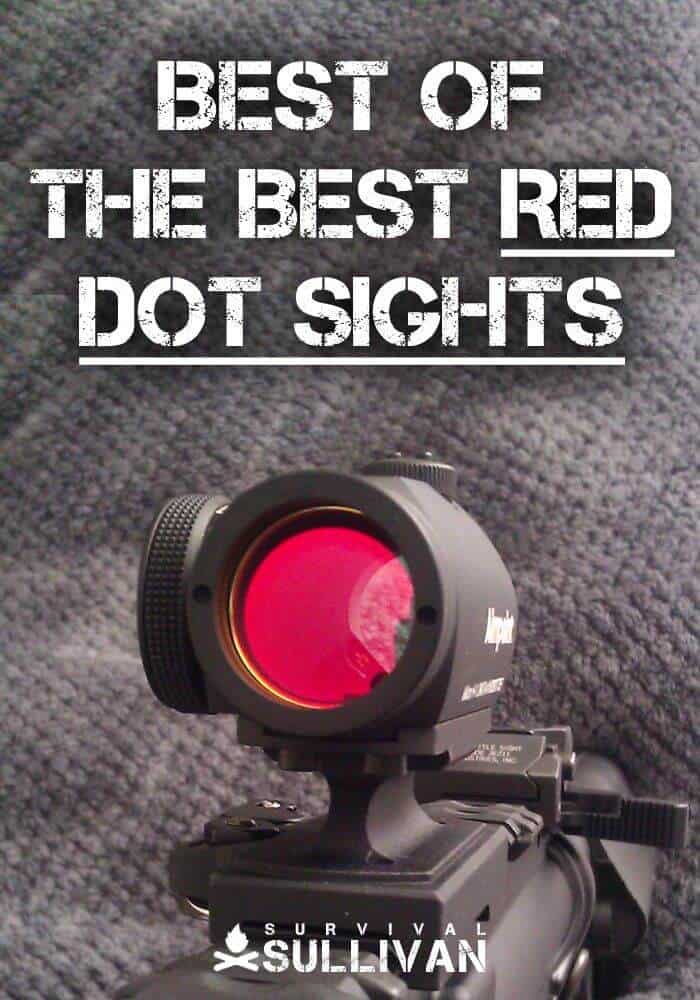Red dot sights are one of the single biggest performance upgrades a shooter can install on a firearm. Their combination of acquisition speed and dead-simple sight picture make them virtually unbeatable by other sighting systems at close to medium range.
Among modern models, their ruggedness and long battery life make them an obvious choice for a primary sight.
Red dot sights, or RDSs, are approaching ubiquity on firearms of all kinds, from rifles and carbines to shotguns and handguns.
Any firearm benefits from an RDS over conventional iron sights except in one or two very specific circumstances. We see them adorn the patrol carbines of modern police officers, military issue weapons of all kinds and the pistols, rifles and shotguns of citizens of all stripes.
Red dots are here to stay, and will only become even more common as technology and acceptance of their benefits continues to grow and spread. While choosing an RDS as your primary sight is easy, deciding on which one to get is definitely not: we have never before had so many choices and so many good choices on the market as we do now.
In this article, I’ll be giving you a few pointers on selecting the best red dot sight for your budget and application as well as providing a list of some of the very best options available today.

Benefits of Red Dot Sights
The benefits of quality red dot sights far, far outweigh any real or perceived disadvantages. The greatest benefit conveyed by these terrific optics is that they allow the shooter a single aiming reference instead of two as with irons, and also permit the shooter a single focal band to verify the sight picture.
To expand on that, with iron sights a shooter must align the front sight with the rear sight and then both sights on the target to ensure proper alignment for intended shot placement. When breaking the shot, the shooter’s focus should be hard on the front sight, not the target, in most instances.
Because humans can only focus at one depth at a time, this means a shooter must switch their focus from the target to the front sight and back repeatedly in the course of an engagement to verify target status and proper sight picture.
This is of course achievable, but not the easiest thing to accomplish without much practice and refinement. Biologically speaking, this is swimming upstream, as in all history since the advent of firearms, and certainly the invention of proper iron sights humans have always utilized a threat-focus when employing a weapon.
RDSs work with our biology instead of against it (unlike proper iron sight employment) by providing a single aiming reference, the reticle, with an infinite focal length.
Considering the shooter no longer has to align two sights, front and rear, to aim the gun, this is already a substantial improvement over irons, being both much simpler and faster to acquire.
What this means practically, is that the shooter only need to place the dot/crosshair/whatever on the target at the desired POI and break the shot cleanly to get a hit. Once zeroed, there can be no true error in sight alignment.
What’s more is the shooter is not, thanks to the reticle’s infinite focal length, the shooter can acquire the target and keep their focus on the target while they acquire a good sight picture: they do not need to, and indeed should not, focus on the reticle itself.
This method allows far faster and more precise shots to be made while preserving excellent target awareness compared to iron sights, and all this to be realized with less practice. The benefits over irons are nothing short of enormous, and applicable at any range that irons may be used with success.
Do not be deluded by anachronistic naysayers who still decry red dots as gamer crap, unreliable or anything else. The benefits of RDS’s are real, and conferred with only a little practice. The fact that these sights require batteries is no reason at all to discount them, even for survival or tactical use.
With many models featuring battery life in hundreds to thousands of hours, and top-quality sights by Aimpoint offering battery life in the tens of thousands of hours, even years, keeping a few batteries handy and changed is beyond simple, and a tiny price to pay for a big boost in performance.

Reliability and Endurance of Red Dot Sights
Compared to sights from just 20 years ago, to say nothing of optics from 30 or 40 years back, modern RDS’s are marvels of reliability, and may have battery life measured in literal years.
Compared to predecessor optics, the highest grades of modern RDS’s are extraordinarily durable, able to shrug off impacts, water immersion and other damage that would have been an instant and unrecoverable knockout just a couple of decades ago.
This durability does come with a price, and you should not be expecting it to feature in the perks of a sub- $100 hobby-grade sight, but even among budget options there can be found impressively rugged performers if one knows what to look for.
Battery life, too, is dependent largely on price range and type of optic (laser or LED) but for most today you can expect a great many hours on a medium daylight visible setting.
In fact, red dot sights have become so reliable and have such long run-times that, on carbines at least, we are actually seeing some duty and defensive rifles omit iron sights entirely with success and certainty.
This is not the opinion of competition shooters and gamers, either: ask the most active professional trainers in the gun world and you may be surprised to hear them back up such a claim.
All total, a good red dot is more than reliable enough and endurance enough for any defensive or survival task. The batteries they do require are inexpensive, high performance and easily stash on a long gun or in your kit so you can always be assured of having multiple spares if you put in a just a little pre-SHTF preparation.

RDS Myths and Common Concerns
Below is a list of the most common complaints, concerns and myths concerning RDS’s. Some are baseless or outmoded, others are legitimate, but all can be answered decisively here.
“I won’t rely on anything that runs on batteries!”
Seriously? You hate electricity that much? Does this include cars, radios, etc., too? While logistics concerns are valid, the groundless hate and skipping of RDSs as valid sighting systems for survival is too big a whopper to take seriously.
No matter which sight you choose, 2 or 3 extra batteries, possible even stashed in the grip or stock of your gun, will be more than enough for almost any occurrence. If you discounting red dots for true end-of-world scenarios because the world may theoretically run out of batteries, well, I don’t know what to tell you. You can always fall back on iron sights, I guess, but I want a red dot for as long as I can keep it powered.
“Red dots are not accurate at range!”
How much accuracy do you need, and at what distance? When you stop to consider that the huge majority of domestic shooting scenarios are resolved well within 100 yards, you should question how much precision you are likely to need.
It is true that, depending on the size of your reticle it will cover some of your target at extended distances, but there are workarounds for that in the form of dimming your sight so you cope with less “bloom” or knowing your holds so you can hold under or over the target appropriately. Most shooters will be golden with a red dot anywhere from point blank to 150 yards or so.
A skilled shooter can work a red dot out to 200 yards and even a little beyond if their eyes are up to the task. If you seriously are anticipating shooting primarily at those ranges then a telescopic sight of some nature will likely be a better choice, or you could choose to add a magnifier to your red dot.
“Red dots are too prone to breakage.”
Some are, some aren’t. For those who only have experience with cheap, $30.00 Chinese red dots, they have no doubt founded their opinion on experience.
But for anyone who has used an Aimpoint, Trijicon or Vortex red dot, they cannot say that in good conscience as these sights are in many ways more reliable than most of the guns they could be mounted to.
The best sights are built to withstand enormous impacts, g-forces and temperature extremes with no loss in performance. Some surly souls proclaim, bizarrely, that their red dot sight could get shot off the gun as If that is somehow a disqualifier for use. Sure, and your irons could get shot off the gun, or your gun could take a direct hit, wrecking it…
“Red dots are expensive.”
They can be if you want one good enough to bet your life on its performance. Most decent red dot sights start at about $200 and go up from there, with really good ones beginning around $375.
Cheaper options do, in theory, offer the same aiming benefits to the shooter, but are far less reliable, less durable and have much inferior battery life compared to their nicer competitors. These cheapo sights may be fine on a fun gun, but should never be considered for life-or-death applications.
Some shooters balk at a sighting option that may cost half as much or more than the gun itself they are installing it on, but once again the benefits you reap and certainty you gain from purchasing quality are far greater than the comparatively small investment you make in a good optic.
The Backup Iron Sight Question
Backup iron sights in conjunction with a red dot sight have long been seen as mandatory equipment. This is partly due to many legacy red dots being inadequate in terms of reliability or battery life.
While modern red dots overall are very reliable, and some are exceptionally reliable, many shooters still feel iron sights are must-have equipment in tandem with any RDS.
Where you fall on this matter is up to your preference. Even the though the most reliable of red dot sights, like those produced by Aimpoint, make backup sights statistically irrelevant, some folks are simply not comfortable without them.
Other shooters, often those who have tons of rounds downrange and hours on a similarly equipped gun have learned firsthand that the only thing outside their control that will truly knock-out a red dot and has some likelihood of occurrence is the optic getting shot by enemy fire.
Personally, even though I am a staunch advocate of RDS’s for any task they are suited to, in all forms and for all weapons, I still want backup sights on my personal guns.
My reasoning is this: iron sights are small, unobtrusive, and weigh so little in any form that their inclusion on the gun is worth it for me to have a secondary sighting option to deal with any mishap or accident involving my red dot.
I am more aware than most shooters of just how unlikely I am to need them, but then again this is one of those pieces of equipment that, should you need it, you’ll really, really need it.
Of course to make use of iron sights you will likely need to equip your RDS with a quick-detach mount so you can shuck it quickly if it goes down hard.
Many a shooter plans and trains to simply stand up the irons and use them through the lens of their optic in the case of battery failure, and this is fine, but there are other likely accidents that can prevent that from working as intended; things like shattered or occluded glass, mud or other debris packed into either end of the optic, etc.
In one of those cases having the ability to quickly ditch the optic, stand up the irons and get back on target is invaluable.
The Players
My four favorite RDS manufacturers are Aimpoint, Vortex, Leupold and Trijicon, in no particular order. Each of them make very good to excellent red dot sights, and each also has a model that is particularly well suited for certain applications compared to its competitors.
All of the optics on this list will come from one of them. Below I will give a brief accounting of these manufacturers trademark characteristics and what their offer (generally) to you the shooter.
Aimpoint
The originators of the red dot (Armson’s OEG not counting as a true red dot sight), and the current manufacturer to beat when it comes to ruggedness and battery life.
Aimpoint’s quality across all models is peerless, and they have long been issued to militaries across the world as standard equipment, and hungrily sought out by both police agencies and in-the-know civilians. Most of their models feature battery lifespans measured in years when left on full time, ready to use, thanks to their patented ACET technology.
All this goodness comes at a price, and Aimpoint is one of the most expensive manufacturers of this type of sight, though they introduced less-expensive models that are still superb about 6 years ago. If you truly want a sight that will, very literally, function to the ending of the world, accept no substitutes.
Vortex Optics
Vortex made a name for themselves with their magnified rifle scopes, particularly their LPVO’s, and their Literally-No-Matter-What warranty, but have steadily made inroads into the RDS market over the last several years.
Their SPARC and Strikefire series dots are the very best in the under-$300 bracket, and they also offer pretty good miniature red dots for a variety of applications.
If you need a solid red dot on a tight budget, make Vortex your first stop, and likely only, stop on your shopping list.
Leupold
Among long range shooters of all stripes, Leupold needs no introduction. Their rifle scopes, no matter the type, are of excellent quality, shining clarity and legendary toughness.
Leupold also makes several red dot sights, of particular note their DeltaPoint and DeltaPoint Pro MRDS’s, on one of the few true duty-grade competitors in that category to the dominance of Trijicon’s RMR series.
If you are seeking an MRDS, you must give the DeltaPoint Pro series a close look.
Trijicon
The legendary maker of countless night sights and over one million of their iconic ACOG rifle scopes, Trijicon’s commitment to innovation and quality is boundless. While they make all kinds of sighting solutions, their red dot sights are the subject of our interest today, particularly the MRO and SRS series sights.
Trijicon is another manufacturer whose sights are known for extreme ruggedness, battery life and sometimes battery independence in the form of full-time tritium and solar illumination sources.
The Sights
Below is my list of RDS options that meet my standards for usability, reliability and battery life. I have listed them in no particular order save by manufacturer.
I have included a description of all pertinent features, technology and what the model is ideally suited for to offer a quick reference for those looking for a sight for a certain task.
Aimpoint PRO – Best Value
Aimpoint’s PRO or Patrol Rifle Optic represents a distillation of their experience with the long-serving Comp M2 and Comp M3 models. The Aimpoint PRO may be Aimpoint’s “budget” model, but it is superior to most other companies RDSs’.
Boasting the nearly invincible durability that Aimpoint is rightly famous for and a 3 year lifespan, constantly on, with a single battery, this is what most have come to expect from Aimpoint.
The inclusion of a quick-detach QRP2 self-torquing mount with a removable spacer, flip up lens covers and night vision compatibility makes this a turn-key package for anyone desiring supreme durability and battery life.
While no longer the smallest form factor that Aimpoint makes, the PRO, like the Comp M2 and M3 before it is far from portly, and will be at home on most rifles and carbines. The PRO features a simple 2 MOA dot reticle for better precision, is waterproof to 150 feet and features the exceptionally clear glass that Aimpoint is also known for.
Far and away the best value in red dot optics on this list, and unbeatable at around a $400 street price.
Aimpoint Comp M4 or M4S – Best Future- Proofed RDS
The Big Bro of Aimpoint models, on the surface this sight seems unremarkable compared to its siblings save for its use of a single, common AA battery. It is more than a battery change as a single AA fuels the M4 with over 8 years of constant on runtime! That is 80,000 hours.
What’s more, the Comp M4 is one of the most commonly issued military sights issued to NATO countries, including the U.S. Army. The M4 is bar-none the most rugged sight that Aimpoint produces, completely waterproof to 150 feet, and among the long line of super-tough RDS’s they have produced that is saying something.
A standard 2 MOA dot reticle provides an excellent blend of precision and speed, and brightness is dial adjustable between 7 night vision and 9 daylight settings to suit any preference or conditions. The M4 features a high mount battery compartment while the M4S features a low battery compartment. That is the only difference between the sights.
The Comp M4 sights are a little heavy, and very costly, with a street price around $800. Not a sight that many will be able to justify purchasing, especially compared to the excellent PRO above, but this is also a sight that you not need to worry about replacing or becoming obsolescent for a very long time: sights may get smaller, but is very unlikely that even Aimpoint will come out with something drastically better than the Comp M4 anytime soon.
Aimpoint Micro T-1 – Best All-Around RDS
Aimpoint’s Micro series sights made a splash back in 2007, offering an unprecedented combination of tiny size, ultra-durability, battery life and clarity.
This tiny optic offers over 50,000 hours of battery life on one common CR2032 battery, and offers both a 2 MOA and 4 MOA dot model to suit your host firearm or preferences. More than the PRO or Comp M4 above, the
Micro series sights are totally at home on virtually any firearm, from handguns to rifles to shotguns, and can accept a mount to work on virtually any application, even piggybacking on top of or in tandem with larger magnifying optics. For saving weight and bulk, this is the best value in Aimpoint’s catalogue.
The Micro T-1 is your do-it-all optic to take on the world, and gives up nothing in the way of performance to its larger siblings. Street price is around $600.
Aimpoint Acro P-1 -Best Weatherproof MRDS
Let me tell you, direct-mounted MRDS’s have a tough gig on pistols: the g-forces incurred from riding on a reciprocating slide are enormous, and even the very best of the breed, including Trijicon’s excellent RMR sights, suffer from greatly reduced lifecycles.
Aimpoint, slow to get into the exploding MRDS market, finally unveiled their first, true MRDS, the Acro P-1, in 2018. Featuring a completely enclosed LED and body, the Acro hopes to solve the short lifecycle issue incurred from shock, while still featuring excellent battery life of over a year and the optical quality that Aimpoint fans love.
While a little larger than its competitors thanks to its fully enclosed design, the Acro P-1 is nonetheless very compact, and is not vulnerable to LED occlusion in the same way other, “open” MRDS’s are, and is submersible to a depth of 82 feet. Street price is about $600.
Vortex SPARC II – Best Budget RDS
Combining a compact form factor to rival Aimpoint’s Micro series and surprisingly solid durability, the SPARC II is a feature-rich quality sight for the money. A 2 MOA red dot allows plenty of precision and this sight includes an adjustable height mounting system so you are ready to roll on a rifle or shotgun right out of the box.
Featuring a battery life of over 1,000 hours on a medium setting, with a 12 hour auto-shutoff, the SPARC II will not go quite as long as the Aimpoints above without babysitting or battery changes, but that is still a highly respectable run time.
10 brightness settings will cover all lighting conditions and coated external lens surfaces help ensure even light transmission and clarity. A commendable sight and one of Vortex’s flagship offerings in this category. A steal at $200.
Vortex Strikefire II – Best Budget RDS for Big Bore Applications
A little larger than the SPARC II above, the Strikefire II features a selectable red or green 4 MOA dot for speed and shooter preference or variable environmental conditions, 10 brightness settings and plenty of windage and elevation adjustment.
A single-piece aluminum body and Vortex’s highest recoil rating makes this optic a great, less-expensive choice for those who plan to mount a red dot on a dedicated shotgun or other firearm with pounding recoil.
The included cantilever mount is suitable for AR mounting out of the box and will produce a lower 1/3rd co-witness. Standard 30mm rings allow the user to mount it lower if required. This nice sight will not set you back by much.
Vortex AMG UH-1 – Best Holographic Sight
Vortex’s newest offering in the category is a true holographic sight; one that promises to deliver the battery life of a traditional LED powered RDS while offering the reduced muzzle-side signature, clarity and precision of legacy holographic weapon sights.
The UH-1, colloquially called the “Huey” after the famous Bell helicopter, is feature laden and impressive: offering a choice of standard CR123A lithium batteries or rechargeable LFP123A batteries with removal-free recharging, 15 intensity settings and that great dot-in-crosshair circle for an ideal combination of precision at range and blinding speed up close, the UH-1 strives to erase all the bad memories accumulated over the years by the ill-fated EO Tech HWS sights.
The only dings against this sight is that it has a large overall form factor and an integrated mount that make it ideally suited to AR rifles, but it can be clumsy on guns with traditional stocks or low combs.
Still, the UH-1 is gathering notoriety as one of the only reliable holographic sights worth the coin, and this being backed up by Vortex’s legendary warranty and customer service seems to give that credence. Street price for this new sight is about $500-$600.
Leupold DeltaPoint Pro – Best MRDS for Instant Readiness
Leupold’s DeltaPoint Pro is an evolution of their earlier and successful DeltaPoint sights, most welcome being the ability to change the battery with the optic still mounted.
Crafted from magnesium and featuring an amazingly clear aspheric lens that affords edge to edge clarity and clearness with as near to true color perception as current optical coating allows, the DeltaPoint Pro is certainly inheritor to Leupold’s legacy of optical excellence.
The most innovative feature of the DeltaPoint Pro is its approach to battery life: instead of using a bigger, more energy-dense battery or some other electronic trickery, Leupold integrated their Motion Sensor Technology into the sight, which automatically deactivates the reticle when no movement has been detected for 5 minutes, and instantly reactivates in upon the slightest jostle.
Admittedly, this type of business usually worries me, as I greatly prefer an always-on sight, but Leupold seems to have cracked the code, and to date I have not experienced any failures with this system aside from a plain dead battery.
The DeltaPoint Pro is at home on handguns and long guns that require an energy-efficient MRDS. Street price is appx. $500
Trijicon MRO – Best Micro Alternative
Trijicon’s MRO, or Miniaturized Rifle Optic, is a direct competitor to the formidable Aimpoint Micro series sights, so you know they have their work cut out for them. Nonetheless, the MRO stands on its own.
With a larger objective lens for better target awareness, optional red or green 2 MOA dot reticle and the strongest alloy housing in the business, the MRO comes in as a worthy American Made competitor to the legendary Micro and does so about $200 cheaper.
The MRO gives up nothing in the way of ruggedness with its recessed and hardened adjusters, heavy duty rheostat and scratch-proof lenses, but some users find it does give up a little bit of optical clarity: as is normal with several Trijicon products, the lens coatings often have a bluish tint to them which some shooters find distracting. While this in no way affects the performance of the optic, it might be distracting to some.
Regardless of any lens coating tint conundrums, the MRO is one of today’s premiere RDS’s, and an excellent entrant in the compact sight derby. Street price is about $425.
Trijicon SRS -Best Wide Angle RDS
The SRS is one of the most interesting sights on this list, both because of its design and its technology. The short, squat body of the SRS combined with a wide objective lens makes for unrivaled field of view and target awareness, and contributes to this sight’s reputation for minimizing the “tunnel” visual phenomenon experienced by some shooters when aiming through a compact RDS.
Even more interesting, the SRS utilizes a unique hybrid power source, with a single AA battery and solar cell working in tandem to supply the sight with power based on user requirements.
Note the SRS requires a battery at all times; the solar cell works to supply as much juice as it can with the battery picking up the slack. Together, the SRS provides great battery life and is a boon to anyone who will be outside doing work with their firearm much of the time.
Additional features include an impressive 165 feet of submersible capability, easy brightness control and the heavy-duty toughness you have come to expect from Trijicon. About $600 on the street.
Conclusion
Red dot sights are the new standard for general purpose rifles, and their advantages are clear and undeniable. If you are serious about self-defense with a firearm, you owe it to yourself and your charges to seek every advantage you can; both training and equipment.
When it comes to equipment, the single biggest upgrade you can make for your connection to the gun is the sights, and no set of iron sights holds a candle to the speed, precision and confidence of a red dot sight. Take a look at the list above and you are sure to find several that will suit your needs.


Charles Yor is an advocate of low-profile preparation, readiness as a virtue and avoiding trouble before it starts. He has enjoyed a long career in personal security implementation throughout the lower 48 of the United States.

Great article and cannot emphazise enough the need for a 3X magnifier to complement your red dot in the event you have to bug out. You ALWAYS want to keep threats at a distance and that is difficult if you cannot get a fix on them.
Great information. I’v been using aTrijicon RMR on a Glock 19 Gen 4. The learning; no the relearning use of a pistol with red dot is huge. But once the skill is master, you will appreciate the advancement of this technology.
Wonderful information, thank you! Possible silly question alert…are RDS systems considered the same as ghost rings? I’ve been considering something better than iron sites for my handgun, since I can’t afford much yet I’ve been trying to learn the difference and see what’s a preferred system for both self defense and also competition shooting. Thanks in advance
You guys hear sig makes A few red dots now?
Scott,
Ghost ring sights are a type of iron sight, specifically referring to the rear aperture-style peep. Think the rear sight on an M4/AR-15.
Hope this helps.
Charles
Scott, the Red Dot Sight is a single point sight. There is a lighted “dot” (or other sighting point) which you place on the target and that is it. Most are powered by a battery. A “ghost ring” is the rear sight of a two point “iron sight” set. It is a circular hole, like a “peep sight” but much bigger. This makes it quicker to use but less accurate that a peep sight.